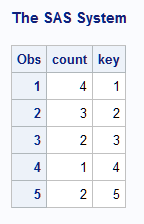REF Method
Consolidates the CHECK and ADD methods into a single method call.
| Applies to: | Hash object |
Syntax
, ...<DATA: datavalue-n>>);
Arguments
rc
specifies whether the method succeeded or failed.
object
specifies the name of the hash object.
KEY: keyvalue
specifies the key value whose type must match the corresponding key variable that is specified in a DEFINEKEY method call.
DATA: datavalue
specifies the data value whose type must match the corresponding data variable that is specified in a DEFINEDATA method call.
Details
rc = h.check();
if (rc ne 0) then
rc = h.add();torc = h.ref();
Example: Using the REF Method for Key Summaries
data keys;
input key;
datalines;
1
2
1
3
5
2
3
2
4
1
5
1
;
data count;
length count key 8;
keep key count;
if _n_ = 1 then do;
declare hash myhash(suminc: "count", ordered: "y");
declare hiter iter("myhash");
myhash.defineKey('key');
myhash.defineDone();
count = 1;
end;
do while (not done);
set keys end=done;
rc = myhash.ref();
end;
rc = iter.first();
do while(rc = 0);
rc = myhash.sum(sum: count);
output;
rc = iter.next();
end;
stop;
run;
proc print data=count;
run;